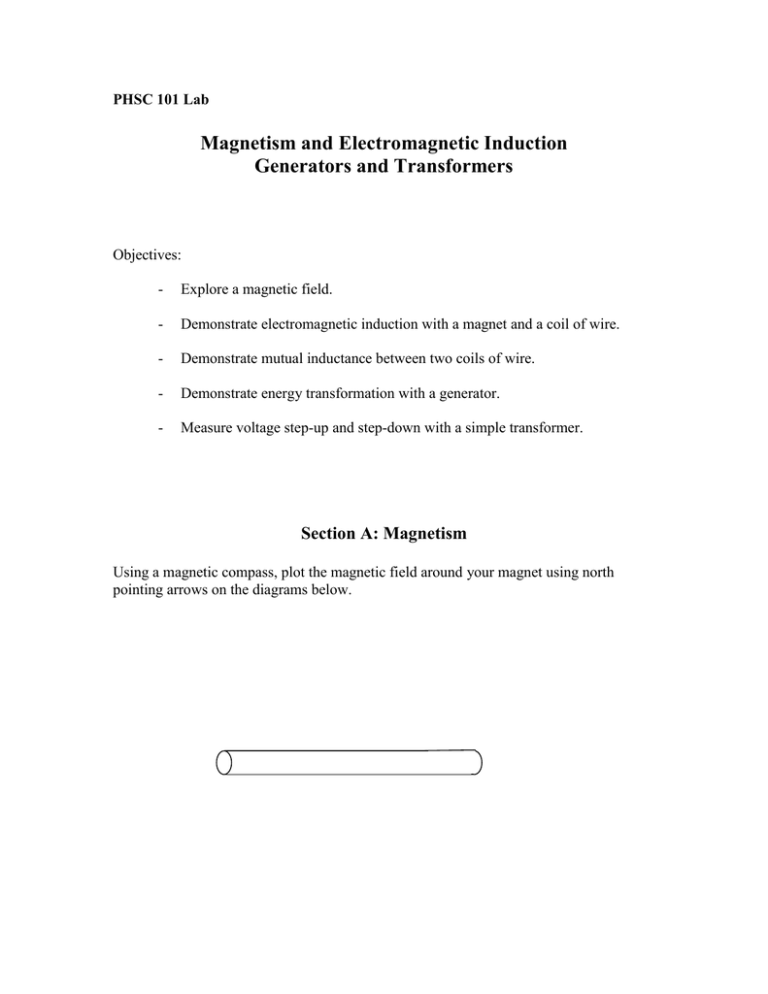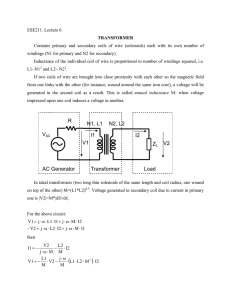Electromagnetic Induction
advertisement

PHSC 101 Lab Magnetism and Electromagnetic Induction Generators and Transformers Objectives: - Explore a magnetic field. - Demonstrate electromagnetic induction with a magnet and a coil of wire. - Demonstrate mutual inductance between two coils of wire. - Demonstrate energy transformation with a generator. - Measure voltage step-up and step-down with a simple transformer. Section A: Magnetism Using a magnetic compass, plot the magnetic field around your magnet using north pointing arrows on the diagrams below. Section B: Electromagnetic Induction A changing magnetic field from a permanent magnet or an electromagnet can induce a potential difference and current in a coil of wire. Take the 200 turn coil and connect it with wires to the galvanometer (the galvanometer is a very sensitive ammeter – take care to keep the battery connections away from it.). Move the magnet toward the coil of wire. What does the galvanometer do (which way does it move and by how much)? Move the magnet away from the coil of wire. What does the galvanometer do? Move the magnet toward the coil of wire rapidly. What does the galvanometer do? Move the magnet away from the coil of wire rapidly. What does the galvanometer do? Exchange the 400 turn coil for the 200 and repeat the above motions. In general, what does the galvanometer do differently with the 400 turn coil? Let’s summarize the electromagnetic induction effect so far: More / less (pick one) current is induced with greater magnet motion. More / less (pick one) current is induced with more coils of wire. Now, let’s see if an electromagnet can induce current in another coil of wire. Leave the 400 turn coil connected to the galvanometer and connect the 200 turn coil in series with the telegraph key switch to the battery (don’t let the battery connections come close to the galvanometer connections). Place the 200 turn coil on top of the 400 turn coil with their holes aligned and hit the switch momentarily. What does the galvanometer do? Now place an iron bar through the holes of the two coils and momentarily hit the switch. What does the galvanometer do now? So the changing magnetic field of the coil connected to the battery can induce a current in a second coil of wire. The iron bar minimizes / enhances (pick one) the electromagnetic induction. Section C: The Electric Generator A moving coil of wire in a magnetic field will have a current induced in it and can produce electrical power. Complete the following exercise on generators. Locate the plastic hand-held generator and leads that go with it. Connect it to a DC voltmeter set to measure up to 20 V. Caution! Cranking on the generator too vigorously can ruin it; it has relatively fragile plastic gears. Turn the crank until you hold a voltage of about 2.0 volts (it will be jumping around, a bit). It will take 10 or 15 seconds to stabilize. Count the number of revolutions that you must turn the handle in 30 seconds to maintain this voltage. Multiply by two and record the rpm required to produce a voltage of 2.0 volts. ____________. Repeat for a voltage of 4 volts. (again wait until you are pretty steady)___________. Make sure that each of your partners gets a chance. What do you conclude regarding the relationship in voltage output to handle speed? Connect the generator to the light bulb. Turn the crank until the light burns with moderate brightness. Disconnect the bulb while you are cranking. Make a mental note on the difference in effort required between the light and no light. Let your partners each experience this effort. Disconnect the bulb and turn the handle at about the same speed. Let your partners do it also. You might try connecting and disconnecting the light while you turn the crank. Explain in terms of work - energy what's going on between you, the generator and the bulb. What's producing the energy, what's using the energy and what's converting one type on energy (what type?), into another (what type?). ________________________________________________________________________ _______________________________________________________________________ ________________________________________________________________________ ________________________________________________________________________ ________________________________________________________________________ Disconnect the generator from the light bulb and connect it to the 1.0 farad capacitor. Turn the handle on the generator at about the rate you were using on the light bulb. Notice the effort on the handle. Does it increase with time (as you are charging the capacitor) or decrease? ____________ After charging the capacitor in this way disconnect the generator (before you stop turning the crank if you can) and connect the capacitor to the light bulb. What do you observe regarding the bulb? What happens as time goes on? ________________________________________________________________________ ________________________________________________________________________ Make a statement following the energy transfers and storage starting with the chemical energy in your body and ending with the light and heat energy from the bulb. ________________________________________________________________________ ________________________________________________________________________ ________________________________________________________________________ ________________________________________________________________________ ________________________________________________________________________ Disconnect the bulb again, and charge the capacitor with the generator. After a few seconds of charging let go of the handle while the generator is still connected. What do you observe? ________________________________________________________________________ ________________________________________________________________________ Did you make a note regarding the direction of the handle? If not observe again. ________________________________________________________________________ Repeat with the generator connected to the light bulb instead of the capacitor. Does the handle continue to move as it did with the capacitor connected? __________ Repeat with the generator connected a 47 Ω resistor. Does the handle continue to move as it did with the capacitor connected? __________ Based on your observations, fill in the answer to the following questions. (more than one may be correct) Which of the following stores electric energy? a. generators b. resistors c. capacitors d. light bulbs Which of the following transforms mechanical energy into electric energy? a. generators b. resistors c. capacitors d. light bulbs Which two of the following primarily consumes electric energy? a. generators b. resistors c. capacitors d. light bulbs Section E: The Electric Transformer Consider a coil of wire connected to an ac voltage source. This primary coil can transmit energy to a secondary coil coupled to it with an iron core through electromagnetic induction via the changing magnetic field in the core. If the ratio of turns of wire of one coil to the other is varied, the voltage can be stepped up or stepped down in proportion to the ratio of coil turns. In a perfect transformer (transformers can have efficiencies as high as 99%) the rate of energy flow from the primary coil (power) is equal to the power into the secondary coil. Since P = IV, if voltage is stepped up, current must be proportionally stepped down. If voltage is stepped down, current must be proportionally stepped up. Transformer equation: Vs / Vp = Ns / Np = Ip / Is where N = number of turns Go to transformer demonstration station #1. A 400 turn coil (primary) is coupled with an 800 turn coil (secondary) via an iron yoke. The 400 turn coil is connected to an ac voltage source generating a bit more than four volts ac. Without changing any settings or connections, turn on the power supply and turn on the two voltmeters measuring voltage across the primary and secondary coils of the transformer. Caution: if you change any settings or connections, you may destroy something. Check with a physics instructor if you’re not sure about the setup, before you turn on the electricity. Note the readings on the voltmeters: Vp __________ Vs __________ Turn off the power supply and voltmeters. Given the primary voltage, in theory what should the secondary voltage be? __________ Show work: What is the percent difference between calculated Vs and measured Vs? __________ Show work: Why might the secondary voltage be different than predicted? Go to transformer demonstration station #2. This demonstration is the same as #1 except the coils have been switched (800 turn coil is the primary and 400 turn coil is the secondary). Without changing any settings or connections, turn on the power supply and turn on the two voltmeters measuring voltage across the primary and secondary coils of the transformer. Caution: if you change any settings or connections, you may destroy something. Check with a physics instructor if you’re not sure about the setup, before you turn on the electricity. Note the readings on the voltmeters: Vp __________ Vs __________ Turn off the power supply and voltmeters. Given the primary voltage, in theory, what should the secondary voltage be? __________ Show work: What is the percent difference between calculated Vs and measured Vs? __________ Show work: Why might the secondary voltage be different than predicted? Homework on next page! Homework Electromagnetism A magnet is inducing a voltage and current in a coil of wire by moving toward it. If you double the magnet’s strength the induced voltage and current _______________. If you double the magnet’s speed the induced voltage and current _______________. If you double the coils number of turns, the induced voltage and current _____________. Transformer Equation Vs / Vp = Ns / Np = Ip / Is where V = voltage, N = number of turns, I = current, s = secondary coil, p = primary coil Vs = Vp (Ns / Np) Is = Ip (Np / Ns) So, voltage is proportional to the ratio of turns (double number of turns doubles voltage), and, current is inversely proportional to the turns ratio (double turns ratio halves current) A primary transformer coil of 100 turns is powered by 120 volts at 2.0 amps. The secondary coil has 2000 turns. What is the voltage across and current through the secondary coil? Remember to show work. (2400 V, 0.10 A)



